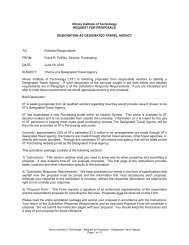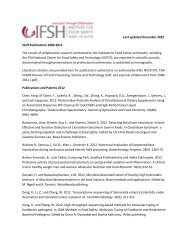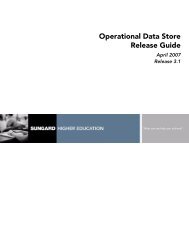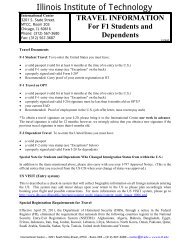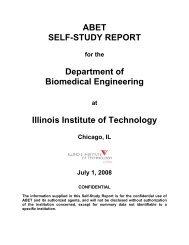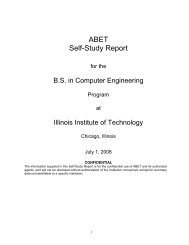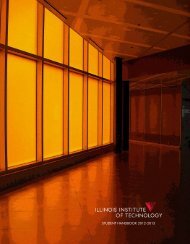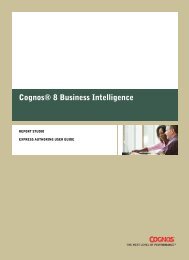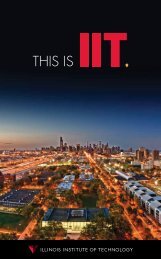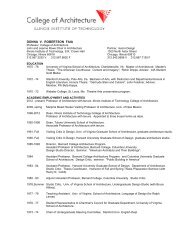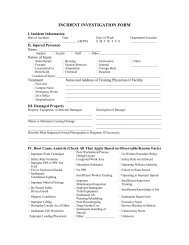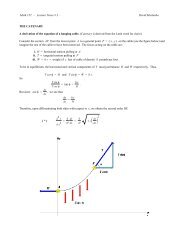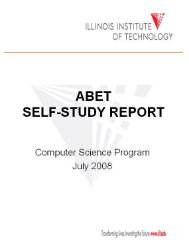Undergraduate Bulletin - Illinois Institute of Technology
Undergraduate Bulletin - Illinois Institute of Technology
Undergraduate Bulletin - Illinois Institute of Technology
You also want an ePaper? Increase the reach of your titles
YUMPU automatically turns print PDFs into web optimized ePapers that Google loves.
Course Descriptions<br />
Alpha-Numeric Indicators<br />
Numbers in Parentheses<br />
The required number <strong>of</strong> lecture hours, laboratory hours, and<br />
credit hours are indicated at the end <strong>of</strong> each course description.<br />
For example, (3-0-3).<br />
Course Identifiers<br />
(C) Identifies courses that fulfill the communications general<br />
educational requirements<br />
(D) CAE design courses<br />
(E) Ethics Content<br />
(H) Identifies courses that fulfill the humanities general educational<br />
requirements<br />
(N) Identifies courses that fulfill the natural science or engineering<br />
general educational requirements<br />
(P) ECE, CPE pr<strong>of</strong>essional elective<br />
(S) Identifies courses that fulfill the social sciences general educational<br />
requirements<br />
(T) CS technical elective<br />
Art and Architectural History<br />
AAH 119<br />
History <strong>of</strong> World Architecture I<br />
Comprehensive background as well as concentration on individual<br />
cultures and their architects from ancient to medieval<br />
times. Discussion <strong>of</strong> architectures from around the world.<br />
Specific details and expressions <strong>of</strong> more generalized theories<br />
and strategies will be explored.<br />
Prerequisite(s): Satisfaction <strong>of</strong> IIT’s Basic Writing Pr<strong>of</strong>iciency<br />
Requirement<br />
(3-0-3) (C)(H)<br />
AAH 120<br />
History <strong>of</strong> World Architecture II<br />
Comprehensive background as well as concentration on<br />
individual cultures and their architects from the Renaissance<br />
to modern times. Discussion <strong>of</strong> architectures from around the<br />
world. Specific details and expressions <strong>of</strong> more generalized<br />
theories and strategies will be explored.<br />
Prerequisite(s): Satisfaction <strong>of</strong> IIT’s Basic Writing Pr<strong>of</strong>iciency<br />
Requirement<br />
(3-0-3) (C)(H)<br />
AAH 322<br />
19th Century American Art & Culture<br />
This course explores the artistic history <strong>of</strong> the United States,<br />
from an agrarian society that developed into an industrialized<br />
nation with a distinguished national art. This broad chronological<br />
survey begins with the colonial art <strong>of</strong> Copley, Peale,<br />
West and Stuart, followed by the nation building iconography<br />
<strong>of</strong> the Hudson River School. The art <strong>of</strong> Mount and Bingham<br />
reflect antebellum culture, followed by Johnson in post-Civil<br />
War America on the eve <strong>of</strong> the Gilded Age. Finally, the<br />
course examines the realism <strong>of</strong> Homer and Eakins, defining a<br />
truly American iconography.<br />
Prerequisite(s): [(HUM 102) OR (HUM 104) OR (HUM 106)]<br />
(3-0-3) (C)(H)<br />
AAH 323<br />
20th Century American Art & Culture<br />
This broadly chronological survey begins with Sargent and<br />
Cassett in the context <strong>of</strong> European traditions. Impressionism<br />
comes to America through the art <strong>of</strong> Chase and Hassam,<br />
and other members <strong>of</strong> “The Ten”. Early Modernism follows<br />
with Henri, Glackens and Sloan, leading artists <strong>of</strong> “The<br />
Eight” and the Ashcan painters, including Bellows. The<br />
major regionalists include Benton, Wood, and O’Keefe with<br />
Hopper emerging as the most significant artist <strong>of</strong> the century.<br />
With New York as the new center <strong>of</strong> Western art in post-war<br />
America, Pollock defines abstract Expressionism, followed by<br />
Warhol and Pop-Art.<br />
Prerequisite(s): [(HUM 102) OR (HUM 104) OR (HUM 106)]<br />
(3-0-3) (C)(H)<br />
AAH 380<br />
Topics in Art & Architecture History<br />
An investigation into a topic <strong>of</strong> current or enduring interest<br />
in Art and/or Architectural History which will be announced<br />
by the instructor when the course is scheduled.<br />
Prerequisite(s): [(HUM 102) OR (HUM 104) OR (HUM 106)]<br />
(3-0-3) (C)(H)<br />
AAH 491<br />
Independent Reading & Research<br />
For advanced students. Instructor permission required.<br />
Prerequisite(s): [(HUM 102) OR (HUM 104) OR (HUM 106)]<br />
(Credit: Variable) (C)(H)<br />
Anthropology<br />
ANTH 200<br />
Introduction to Anthropology<br />
This course introduces students to the vast and exciting<br />
world <strong>of</strong> anthropology using a holistic, four-field approach<br />
to understanding human biological and cultural diversity.<br />
This includes a survey <strong>of</strong> cultural anthropology, linguistics,<br />
biological anthropology, and archaeology. We explore: (a)<br />
human evolution from the earliest primates to modern<br />
humans; (b) methods, theories, and approaches used by<br />
anthropologists; (c) archaeology, technology, and the rise <strong>of</strong><br />
cities; (d) subsistence strategies; (e) marriage, kinship, and<br />
descent; and (f) the role <strong>of</strong> ethnicity in modern life.<br />
(3-0-3) (C)(S)<br />
ANTH 300<br />
Anthropology <strong>of</strong> <strong>Technology</strong><br />
Studies technology from a cross-cultural perspective, using<br />
modern ethnographic and historical case studies. The course<br />
examines an assortment <strong>of</strong> technologies and end-products by<br />
looking at the social, economic, and ideological contexts in<br />
which they are embedded.<br />
Prerequisite(s): [(ANTH 200) OR (PS 190-299) OR (SOC<br />
190-299)]<br />
(3-0-3) (C)(S)<br />
ANTH 359<br />
Humans, Ecology, & Environment<br />
Examines the relationship between humans and nature,<br />
including reasons for some well-known ecological catastrophes<br />
in human history. The course traces changing attitudes to the<br />
environment and explores various measures that have been<br />
<strong>of</strong>fered to solve problems, for instance, the Green Revolution,<br />
sustainable development, renewable energy, “clean” technologies,<br />
and the potential social and ecological consequences <strong>of</strong><br />
these solutions. Same as SOC 359.<br />
Prerequisite(s): [(ANTH 200) OR (PS 209) OR (PS 210) OR<br />
(PS 221) OR (SOC 190-299)]<br />
(3-0-3) (S)<br />
179



